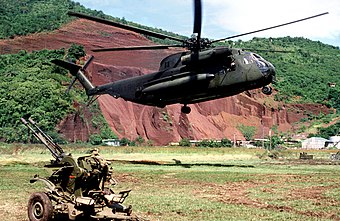
Back غزو الولايات المتحدة الأمريكية لغرينادا Arabic Qrenadanın işğalı Azerbaijani قرنادانین ایشغالی AZB Уварванне ЗША на Грэнаду Byelorussian Invaze na Grenadu Czech Invasionen af Grenada Danish US-Invasion in Grenada German Usona Invado de Grenado Esperanto Invasión de Granada Spanish Grenadako inbasioa Basque
| United States invasion of Grenada | |||||||
|---|---|---|---|---|---|---|---|
| Part of the Cold War | |||||||
 An American Sikorsky CH-53 Sea Stallion helicopter hovers above the ground near an abandoned Soviet ZU-23-2 anti-aircraft weapon during the American invasion of Grenada, 1983. | |||||||
| |||||||
| Belligerents | |||||||
|
| |||||||
| Commanders and leaders | |||||||
| |||||||
| Strength | |||||||
CPF:
|
| ||||||
| Casualties and losses | |||||||
| |||||||
| 24 civilians killed (18 of them when a mental hospital was mistakenly bombed by U.S. Navy A-7s)[3] | |||||||
The United States and a coalition of Caribbean countries (Antigua and Barbuda, Barbados, Dominica, Jamaica, Saint Kitts and Nevis, Saint Lucia, and Saint Vincent and the Grenadines) invaded the small island nation of Grenada, 100 miles (160 km) north of Venezuela, at dawn on 25 October 1983. Codenamed Operation Urgent Fury by the U.S. military, it resulted in military occupation within a few days.[8] It was triggered by strife within the People's Revolutionary Government, which led to the house arrest and execution of the previous leader and second Prime Minister of Grenada, Maurice Bishop, and to the establishment of the Revolutionary Military Council, with Hudson Austin as chairman. Following the invasion there was an interim government appointed, and then general elections held in December 1984.
The invading force consisted of the 1st and 2nd battalions of the U.S. Army's 75th Ranger Regiment, the 82nd Airborne Division, and elements of the former Rapid Deployment Force, U.S. Marines, U.S. Army Delta Force, Navy SEALs, and a small group Air Force TACPs from the 21st TASS Shaw AFB ancillary forces, totaling 7,600 troops, together with Jamaican forces and troops of the Regional Security System (RSS).[9] The invaders quickly defeated Grenadian resistance after a low-altitude assault by the Rangers and 82nd Airborne at Point Salines Airport on the island's south end, and a Marine helicopter and amphibious landing at Pearls Airport on the north end. Austin's military government was deposed. An advisory council designated Sir Paul Scoon as Governor-General of Grenada until the 1984 elections.
The invasion date of 25 October is now a national holiday in Grenada, called Thanksgiving Day, commemorating the freeing of several political prisoners who were subsequently elected to office. A truth and reconciliation commission was launched in 2000 to re-examine some of the controversies of that tumultuous period in the 1980s; in particular, the commission made an unsuccessful attempt to locate the remains of Maurice Bishop's body, which had been disposed of at Austin's order and never found.[10]
At the time, the invasion drew criticism from many countries. British Prime Minister Margaret Thatcher privately disapproved of the mission, in part because she was not consulted in advance and was given very short notice of the military operation, but she supported it in public.[11] The United Nations General Assembly condemned it as "a flagrant violation of international law" on 2 November 1983, by a vote of 108 to 9.[12]
The invasion exposed communication and coordination problems between the different branches of the U.S. military when operating together as a joint force. This triggered post-action investigations resulting in sweeping operational changes in the form of the Goldwater-Nichols Department of Defense Reorganization Act.[13]
- ^ a b c d e Cole, Ronald H. (1997). "Operation Urgent Fury: The Planning and Execution of Joint Operations in Grenada" (PDF). Archived from the original (PDF) on 16 November 2011.
- ^ "Medals Outnumber G.I.'s in Grenada Assault". The New York Times. 30 March 1984. Archived from the original on 13 February 2017. Retrieved 9 February 2017.
- ^ a b c d Clodfelter, Micheal (2017). Warfare and Armed Conflicts: A Statistical Encyclopedia of Casualty and Other Figures, 1492–2015 (4th ed.). McFarland. p. 645. ISBN 978-0786474707.
- ^ "Study Faults U.S. Military Tactics in Grenada Invasion". The Washington Post. Archived from the original on 2 July 2019. Retrieved 2 July 2019.
- ^ "The Invasion of Grenada". PBS.org. Archived from the original on 20 March 2017. Retrieved 27 August 2017.
- ^ Russell, Lee; Mendez, Albert (2012). Grenada 1983. London: Osprey Publishing. p. 45.
- ^ "Soldiers During the Invasion of Grenada". CardCow Vintage Postcards. Archived from the original on 8 December 2015. Retrieved 9 October 2015.
- ^ Kukielski, Phil (8 September 2013). "How Grenada reshaped the US military". The Boston Globe. Retrieved 25 April 2020.
- ^ "Caribbean Islands – A Regional Security System". country-data.com. Archived from the original on 26 April 2017.
- ^ Powers, Martine; Muldoon, Ted; Svirnovskiy, Rennie (8 December 2023). "U.S. may hold key to finding remains of Grenada's prime minister". The Washington Post.
- ^ Moore, Charles (2016). Margaret Thatcher: At Her Zenith. p. 130.
- ^ "United Nations General Assembly resolution 38/7". United Nations. 2 November 1983. Archived from the original on 19 December 2000. Retrieved 5 March 2016.
- ^ Kukielski, Philip (2019). The U.S. Invasion of Grenada: Legacy of a Flawed Victory. Jefferson, North Carolina: McFarland & Company. pp. 213–214. ISBN 978-1-47667-879-5. OCLC 1123182247.